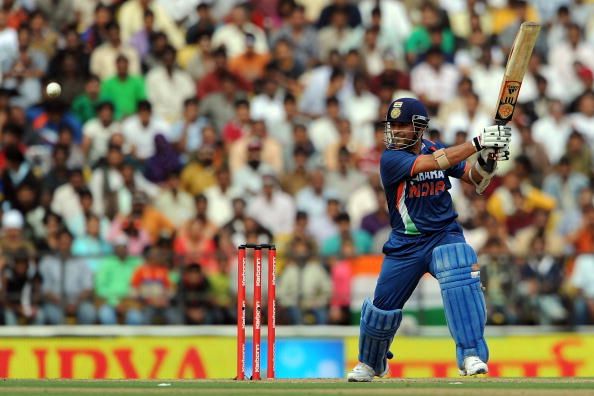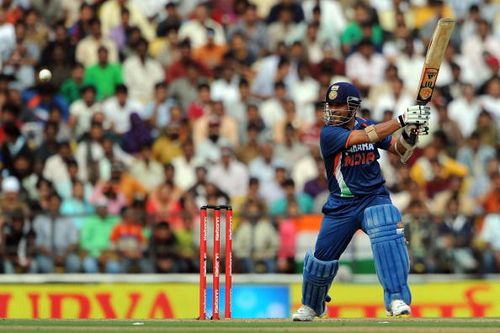
Sachin Tendulkar - The first complete batsman

The retirement of Sachin Tendulkar from the ODI format of cricket has put an end to the career of the greatest batsman to have played the format. To put it in perspective, Tendulkar finished an illustrious career in the 50-over format, having played 463 ODIs, scored 18,426 runs and made 49 centuries, all of them a world record. Plus the first batsman to score a ODI double ton, most man of the series awards, most man of the match awards and innumerable records to show for. None of the other batsman compare up to his numbers in this format.
However, this has started the debate whether he is greatest in the Test format too. His recent travails have compounded the calls for his retirement from that format also, to give youngsters a chance and keep faith in the meritocracy of the system.
I agree that he may not be the greatest in the longest format as his 4th innings average and no triple ton are some of the things that take shine away from his almost superhuman efforts.
However, he was the first complete batsman of this era of 50 over cricket. That is why he was the ‘Master Blaster’, the term used for Sir Vivian Richards. Nobody after Sir Viv has demanded such respect from the opposition bowlers.
He was the first batsman to instil the same amount of fear and command equal respect in those two formats for almost all of his career. The person who came nearest is Ricky Ponting, who pummelled his way to greatness in a short span of 6 year. Taking nothing away from Ponting’s achievements, but the sheer duration of Tendulkar’s consistency in both forms for a sustained duration makes him a far more complete batsman in the past 3 decades. He could be the most complete batsman, even ahead of Sir Viv but I would not compare the two as the eras are different. But in terms of numbers and records, Tendulkar is surely way ahead of him also.
 His positive approach in batting is the cornerstone of today’s high run rate era. Sanath Jayasuriya may get the award for changing the way the first 15 overs were looked at, Virender Sehwag might get the corresponding one for re-inventing Test match opening. But one is likely to forget that the way Sachin played in both forms of the game, his attacking instinct was the thing opposition captains were frightened of. The prime example is the innings he played in Auckland in 1994, 82 runs off 49 balls; a score any T20 specialist would be proud of. That particular innings galvanised his whole career and with it, the manner in which cricket was played. Another example that should not be missed is the way he decimated the South African bowling attack in 1996-97 series in Cape Town, when he made an attacking 169 with 26 fours. He and Mohd. Azharuddin simply shredded the South African attack and added 222 runs in just over 2 hours. Tendulkar showed the world how Test matches could be played, an aggressive approach in hostile alien conditions and with your team under pressure. In fact, no human effort could dislodge him from the crease even after Azhar departed. It took a superhuman effort to dismiss him, a blinder taken by Adam Bacher at deep midwicket boundary, leaping backwards and taking a catch one handed to end arguably one of the finest counter-attacking innings in a Test match.
His positive approach in batting is the cornerstone of today’s high run rate era. Sanath Jayasuriya may get the award for changing the way the first 15 overs were looked at, Virender Sehwag might get the corresponding one for re-inventing Test match opening. But one is likely to forget that the way Sachin played in both forms of the game, his attacking instinct was the thing opposition captains were frightened of. The prime example is the innings he played in Auckland in 1994, 82 runs off 49 balls; a score any T20 specialist would be proud of. That particular innings galvanised his whole career and with it, the manner in which cricket was played. Another example that should not be missed is the way he decimated the South African bowling attack in 1996-97 series in Cape Town, when he made an attacking 169 with 26 fours. He and Mohd. Azharuddin simply shredded the South African attack and added 222 runs in just over 2 hours. Tendulkar showed the world how Test matches could be played, an aggressive approach in hostile alien conditions and with your team under pressure. In fact, no human effort could dislodge him from the crease even after Azhar departed. It took a superhuman effort to dismiss him, a blinder taken by Adam Bacher at deep midwicket boundary, leaping backwards and taking a catch one handed to end arguably one of the finest counter-attacking innings in a Test match.
These are just two examples of how Tendulkar reshaped the batting approach in cricket, his comprehensive technique becoming the inspiration for millions of young players not only in India but in other countries also. How he has shaped the way cricket is now being played, is a testament of his completeness and greatness. His retirement may have put an end to the flowing drives from his bat but he has made sure that it doesn’t from other bats, irrespective of the origin of the bat or the batsman.